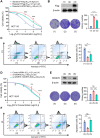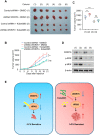WDR76 regulates 5-fluorouracil sensitivity in colon cancer via HRAS
- PMID: 37081180
- PMCID: PMC10119360
- DOI: 10.1007/s12672-023-00656-9
WDR76 regulates 5-fluorouracil sensitivity in colon cancer via HRAS
Abstract
Background: WD repeat domain 76 (WDR76) has been reported in multiple tumors, while without relation to chemotherapy resistance. 5-fluorouracil (5-FU) is widely adopted in treating colon cancer. However, the resistance of WDR76 and 5-FU in colon cancer remains unclear.
Methods: Limma package in R software was employed to analyze the differentially expressed genes. Western blot or quantitative real-time PCR (qRT-PCR) were run to assessed the gene expression. The cytotoxic effect was determined according to cell viability assay, colony formation assay in vitro. Cell apoptosis was assayed using flow cytometry. GSEA analysis was performed to identify pathways related to the target gene. Xenografted mice model was employed to evaluate the tumor growth.
Results: Bioinformatic analysis revealed the higher expression of WDR76 in 5-FU sensitive colon cancer cells compared to resistant colon cancer cells, accompanied by the decreased mRNA expression of WDR76 in 5-FU resistant colon cancer cells. The overexpressed WDR76 resulted in the apoptosis and the downregulated colony numbers in 5-FU resistant colon cancer cells, leading to the elevated sensitivity of 5-FU. Meanwhile, knockdown of WDR76 enhances the resistance of 5-FU in colon cancer both in vitro and vivo, which was reversed by a specific inhibitor of HRAS, Kobe006. An important molecular mechanism of 5-FU resistance lies the degradation of HRAS induced by WDR76.
Conclusion: Our findings demonstrated a role of WDR76 as a promising target for reversing the resistance of colon cancer to 5-FU.
Keywords: 5-fluorouracil (5-FU); Colon cancer; HRAS; WDR76.
© 2023. The Author(s).
Conflict of interest statement
The authors declare no competing interests.
Figures




Similar articles
-
Curcumin synergizes with 5-fluorouracil by impairing AMPK/ULK1-dependent autophagy, AKT activity and enhancing apoptosis in colon cancer cells with tumor growth inhibition in xenograft mice.J Exp Clin Cancer Res. 2017 Dec 22;36(1):190. doi: 10.1186/s13046-017-0661-7. J Exp Clin Cancer Res. 2017. Retraction in: J Exp Clin Cancer Res. 2022 Jun 10;41(1):197. doi: 10.1186/s13046-022-02409-y. PMID: 29273065 Free PMC article. Retracted.
-
Downregulation of lncRNA CCAT1 enhances 5-fluorouracil sensitivity in human colon cancer cells.BMC Mol Cell Biol. 2019 Apr 23;20(1):9. doi: 10.1186/s12860-019-0188-1. BMC Mol Cell Biol. 2019. PMID: 31039730 Free PMC article.
-
Down-regulating IL-6/GP130 targets improved the anti-tumor effects of 5-fluorouracil in colon cancer.Apoptosis. 2018 Jun;23(5-6):356-374. doi: 10.1007/s10495-018-1460-0. Apoptosis. 2018. PMID: 29777330
-
1,3-Bis(2-chloroethyl)-1-nitrosourea enhances the inhibitory effect of resveratrol on 5-fluorouracil sensitive/resistant colon cancer cells.World J Gastroenterol. 2013 Nov 14;19(42):7374-88. doi: 10.3748/wjg.v19.i42.7374. World J Gastroenterol. 2013. PMID: 24259968 Free PMC article.
-
Curcumin Reverses 5-Fluorouracil Resistance by Promoting Human Colon Cancer HCT-8/5-FU Cell Apoptosis and Down-regulating Heat Shock Protein 27 and P-Glycoprotein.Chin J Integr Med. 2019 Jun;25(6):416-424. doi: 10.1007/s11655-018-2997-z. Epub 2018 Nov 27. Chin J Integr Med. 2019. PMID: 30484020
Cited by
-
An integrated structural model of the DNA damage-responsive H3K4me3 binding WDR76:SPIN1 complex with the nucleosome.Proc Natl Acad Sci U S A. 2024 Aug 13;121(33):e2318601121. doi: 10.1073/pnas.2318601121. Epub 2024 Aug 8. Proc Natl Acad Sci U S A. 2024. PMID: 39116123 Free PMC article.
References
-
- Teufel A, Gerken M, Fürst A, et al. Benefit of adjuvant chemotherapy in high-risk colon cancer: a 17-year population-based analysis of 6131 patients with Union for International Cancer Control stage II T4N0M0 colon cancer. Eur J Cancer. 2020;137:148–160. doi: 10.1016/j.ejca.2020.06.036. - DOI - PubMed
LinkOut - more resources
Full Text Sources
Research Materials
Miscellaneous
